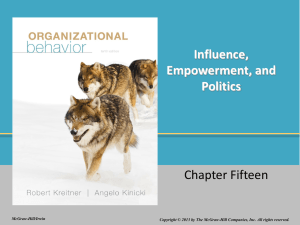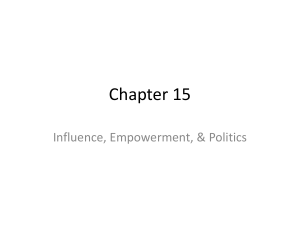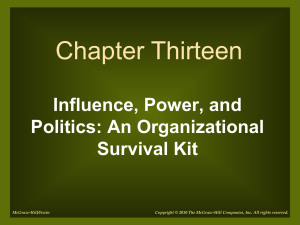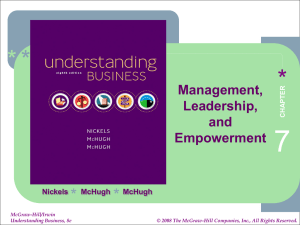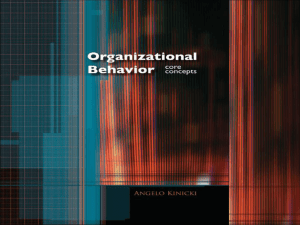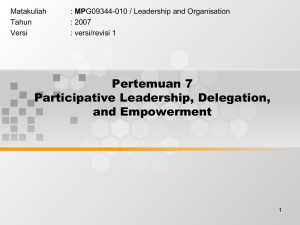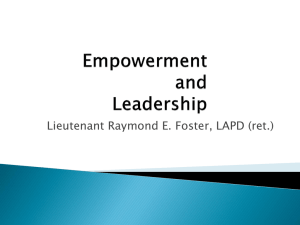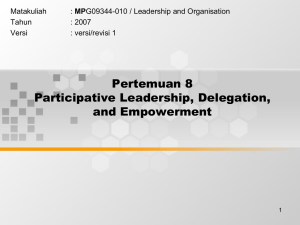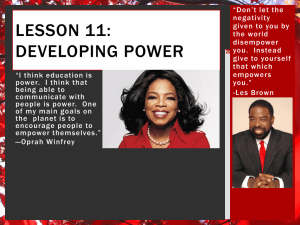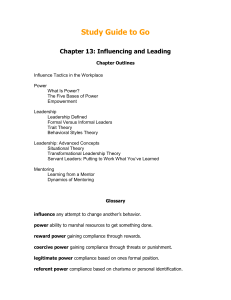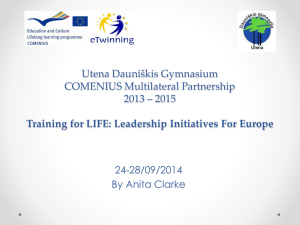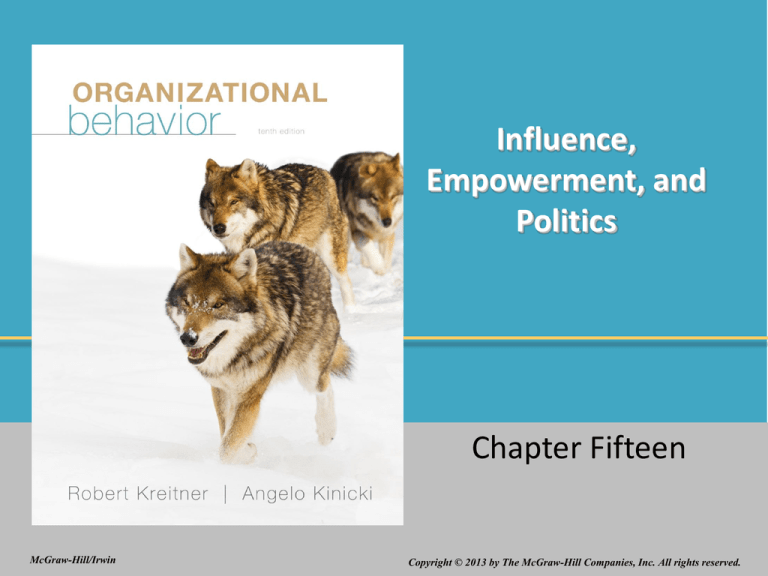
Influence,
Empowerment, and
Politics
Chapter Fifteen
McGraw-Hill/Irwin
© 2013
The McGraw-Hill Companies, Inc. All rights reserved.
Copyright © 2013 by The McGraw-Hill Companies, Inc. All rights reserved.
Learning Objectives
LO.1 Explain the concept of mutuality of interest.
LO.2 Name at least three “soft” and two “hard”
influence tactics, and summarize the practical
lessons from influence research.
LO.3 Identify and briefly describe French and
Raven’s five bases of power, and discuss the
responsible use of power.
LO.4 Define the term empowerment , and explain
why it is a matter of degree.
15-2
Learning Objectives (cont.)
LO.5 Explain why delegation is the highest form of
empowerment, and discuss the connections
among delegation, trust, and personal
initiative.
LO.6 Define organizational politics , and explain
what triggers it.
LO.7 Distinguish between favorable and unfavorable
impression management tactics.
LO.8 Explain how to manage organizational politics.
15-3
Mutuality of Interest
Mutuality of interest
involves win–win situations in which one’s selfinterest is served by cooperating actively and
creatively with potential adversaries.
15-4
The Constant Tug-of-War between Self-Interest and
Mutuality of Interest Requires Managerial Action
15-5
Nine Generic Influence Tactics
1.
2.
3.
4.
5.
Rational
persuasion
Inspirational
appeals
Consultation
Ingratiation
Personal appeals
6.
7.
8.
9.
Exchange
Coalition tactics
Pressure
Legitimating tactics
15-6
Question?
Tami has a tendency to use praise or flattery
with her boss prior to making a request for her
expense account approval every month. Tami
is using which influence tactic?
A.Inspirational appeal
B.Ingratiation
C.Pressure
D.Consultation
15-7
Three Possible Influence Outcomes
1. Commitment
substantial agreement followed by initiative
and persistence in pursuit of common goals
2. Compliance
reluctant agreement requiring subsequent
prodding to satisfy minimum requirements
15-8
Three Influence Outcomes
3. Resistance
stalling, unproductive arguing, or outright
rejection
15-9
Practical Research Insights
Commitment is more likely when people rely on
strong rational persuasion and do not rely on
pressure and coalition tactics.
Ingratiation can slightly improve your performance
appraisal results and make your boss like you
significantly more.
Interpersonal influence is culture bound.
15-10
Social Power
Social power
ability to marshal the
human,
informational, and
material resources to
get something done
15-11
Two Types of Power
Socialized power
plans, self-doubts,
mixed outcomes
and concerns for
others
Personalized
power
expressions of
power for the sake
of personal
aggrandizement
become paramount
15-12
Personalized Power
Personalized power is exhibited when
managers:
Focus more on satisfying their own needs.
Focus less on the needs of their underlings.
Act like “the rules” others are expected to
follow don’t apply to them
15-13
Five Bases or Power
Reward
Referent
Expert
Coercive
Legitimate
15-14
Five Bases of Power
Reward power
obtaining compliance by promising or granting
rewards.
Coercive power
obtaining compliance through threatened or
actual punishment.
Legitimate power
obtaining compliance through formal authority.
15-15
Five Bases of Power
Expert power
obtaining compliance through one’s knowledge
or information.
Referent power
obtaining compliance through charisma or
personal attraction.
15-16
Question?
As a Division Head, Natalie is implementing
pay-for-performance plans and positive
reinforcement programs at Goodwill Wireless
Center. Natalie is attempting to exploit which
power?
A.Coercive
B.Expert
C.Referent
D.Reward
15-17
Research Insights about Social Power
Expert and referent power had a generally
positive effect
Reward and legitimate power had a slightly
positive effect
Coercive power had a slightly negative
effect
15-18
Empowerment: From Power
Sharing to Power Distribution
Empowerment
recognizing and releasing into the organization
the power that people already have in their
wealth of useful knowledge, experience, and
internal motivation.
15-19
The Evolution of Power
15-20
Participative Management
Participative management
process whereby employees play a direct role
in setting goals, making decisions, solving
problems, and making changes in the
organization
15-21
Participative Management
Participative management helps employees
fulfill three basic needs:
Autonomy
Meaningfulness of work
Interpersonal contact
15-22
Question?
Herman is able to work more on his own now
that his supervisor has given him more
responsibility and authority in his job. Which
need of participative management does this
fulfill?
A.
B.
C.
D.
Autonomy
Meaningfulness of work
Interpersonal contact
Sovereignty
15-23
Delegation
Delegation
the process of granting decision-making
authority to lower-level employees
amounts to power distribution
15-24
Barriers to Delegation
Belief in the fallacy, “If you want it done right, do it
yourself.”
Lack of confidence and trust in lower-level
employees.
Low self-confidence.
Fear of being called lazy.
Vague job definition.
Fear of competition from those below
15-25
Personal Initiative: The Other Side of
Delegation
15-26
Personal Initiative
Personal initiative is characterized by the
following aspects:
1.consistent with the organization’s mission,
2.has a long-term focus,
3.goal-directed and action-oriented,
4.persistent in the face of barriers and
setbacks
5.self-starting and proactive.
15-27
Randolph’s Empowerment Model
15-28
Four P’s of Political Success
Power Assessment
How can you improve your leverage position?
Performance
How can your work make the business more
successful?
15-29
Four P’s of Political Success
Perception
How can you enhance your reputation,
especially with those who can achieve your
goals?
Partnerships
How can you increase your network of allies
and supporters?
15-30
Domain of Organizational Politics
Organizational politics
intentional acts of influence to enhance or
protect the self-interests of individuals or
groups
15-31
Sources of Uncertainty
1.
2.
3.
4.
5.
Unclear objectives
Vague performance measures
Ill-defined decision processes
Strong individual or group competition
Any type of change
15-32
Levels of Political Action in
Organizations
15-33
Levels of Political Action
Coalition
an informal group bound together by the active
pursuit of a single issue
15-34
Common Political Tactics in
Organizations
15-35
Question?
Whenever things don’t go well for Duane, he
is quick to shift fault to others. Which political
tactic is he using?
A.
B.
C.
D.
Creating a favorable image
Praising others (ingratiation)
Attacking or blaming others
Using information as a political tool
15-36
Impression Management
Impression management
the process by which people attempt to control
or manipulate the reactions of others to images
of themselves or their ideas
15-37
Favorable Impression Management
Job-focused
manipulating information about one’s
performance
Supervisor-focused
praising and doing favors for one’s supervisor
Self-focused
presenting oneself as a polite and nice person
15-38
Question?
Kendall will often do favors and run errands
for her manager. She is engaged in
__________ impression management.
A.Job-focused
B.Supervisor-focused
C.Self-focused
D.Organization-focused
15-39
Video Case: Dealing with Office
Bullies
Can workplace bullying lead to conflict
between managers and subordinates?
Why is bullying a concern to organizations?
What are some of the adverse affects of
bullying in the workplace?
How can office bullying be managed? Is
there legal recourse for victims of bullying?
15-40

